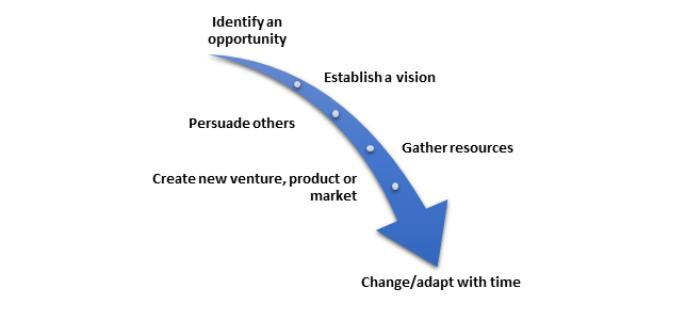The process of entrepreneurship can be observed through the six-stage process. According to Lall & Sahai (2007) entrepreneurial process begins when the entrepreneurs spot opportunities which others do not. They have clear understanding of the concept of their business venture and try to achieve their missions, objectives and their goals through their vision. They have the abilities to communicate their vision of their business engagements and gather necessary information to make their vision becomes a reality. In addition, they organise and manage several resources to create their products/services and adapt themselves to the market changes accordingly. Figure 1 illustrates the entrepreneurial process involved for creating and developing new entrepreneurial ventures.

By following the process as mentioned in the Figure 1, this section provides some information concerning each of the above mentioned aspects of the entrepreneurial process.
Identifying an opportunity: This aspect is considered as the first step towards the creation and running a successful firm. Entrepreneurs have the ability to identify the opportunities where other people see impossibilities and hurdles. Identification of opportunities at an appropriate time is considered as important criteria for entrepreneurs as it offers the advantages of being the first mover. This offers an opportunity for the business to stay ahead of the others in terms of market credibility, profits and better economies of scale. Entrepreneurs sense these opportunities as they are highly creative and are equally open to new ideas. Besides, managing the seamless operations in their business ventures, they often accept challenges in the road map for success (Lall & Sahai, 2007).
Establishing a vision: Besides seeking opportunity, an entrepreneur can develop a futuristic vision for the business by establishing the business mission, objectives and the goals of the company. Entrepreneurs can create a vision for the business by visualising them through their optimism and perseverance. Vision helps the entrepreneurs to steer the company in proper direction and also facilitates them to adapt and navigate through different market conditions prevailing in the markets (Lall & Sahai, 2007).
Persuading others: Entrepreneurs do not necessarily work in isolation. However, they are often working with other people in their business venture. It becomes highly important for the entrepreneurs to create and develop a foundational team, which consists of founding group members who could work together to accomplish the goals and objectives of the firm. In addition, the entrepreneur can draft a detailed business plan to guide the group members to achieve the goals, objectives, mission and consequently the vision of the company. The participants in these ventures can be investors or stakeholders, and also members who participate in different business functions of the firm, such as finance, marketing, accounting and HRM (Lall & Sahai, 2007).
Gathering resources: Besides spotting opportunities, establishing vision and persuading other individuals; entrepreneurs require enormous amounts of information and resources to help them achieve their missions. In this phase, the entrepreneurs are driven purely by seeking resources to operationalise their ventures. It becomes hugely important for the entrepreneurs to spot and acquire genuine resources for developing their structures, information systems, financial strength, operational capacities and human capital. In addition, once the resources are gathered, a proper procurement policy is required for healthy functioning of the entire business operations (Lall & Sahai, 2007).
Gather resources for information: With an increasing demand to seek real-time information. Entrepreneurs are relying on data, information and knowledge through information systems for managing their business processes. The use of information systems has been hugely beneficial for the managing company’s business processes and also the personnel who use them. The use of information systems offers the personnel, suppliers, customers and other participating stake holders to share appropriate information on real-time basis. This would help the entrepreneurs to understand the condition and situations of their business processes and eventually the position of the businesses on a daily basis (Lall & Sahai, 2007).
Create new venture: Once the entrepreneur organises all the required resources and information required in the above mentioned stages, the next phase for the entrepreneur is to create a new business venture which involves hard work to gather resources and allocate them to respective business functions (Lall & Sahai, 2007).
Change/adapt with time: As change has become inevitable in contemporary business environments, entrepreneurs are required to constantly upgrade their business processes for developing seamless operations. Entrepreneurs are often required to understand their present and their future requirements to provide uninterrupted products/services to their customers/ In addition, entrepreneurs are also required to understand the current and emerging issues of the company, and acquire resources (financial, human capital, machinery, material) accordingly. This requires entrepreneurs to look for emerging technologies and resources for providing seamless flow of products or services and adapt to dynamic business environments accordingly (Lall & Sahai, 2007).

